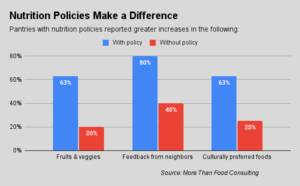Like other food banks, Greater Pittsburgh Community Food Bank is striving to distribute more produce by making it at least 50% of the total amount of food it delivers. It’s getting closer to this goal, thanks in part to a novel way of pushing produce out to its pantries.
Its Advance Choice program turns the typical produce distribution on its head: instead of pantries placing orders for produce off the food bank’s inventory, Greater Pittsburgh Community Food Bank proactively sources produce according to pantry preferences and delivers it to pantries “just in time.” Because clients pick up the produce immediately, pantries don’t need refrigerators to store it, resolving one of produce’s bigger complications.
A seemingly simple change, Advance Choice resulted in families receiving 60% more produce from participating pantries in the first year of the program. Overall, produce distributions increased by more than half a million pounds in the first year. And with only one-fourth to one-third of pantries on the program so far, there is still a lot of room for expansion.

“When we get produce, we’re able to send it out right away without asking the pantries if they want it and without waiting for them to make a produce order,” said Erin Kelly, Director of Health and Wellness at Greater Pittsburgh Community Food Bank. “It’s helped get a lot more produce through our facility.”
The idea of pushing out more produce gained greater urgency once the food bank conducted a survey that found that 80% of the households it serves has at least one person with at least one diet-related disease, such as diabetes or obesity. Despite the great need for healthy food, only 9% of respondents said that fresh fruits and vegetables were both available and affordable in their areas. “That’s 91% who are not able to access fresh produce,” Kelly emphasized.
In addition to the Advance Choice program, the food bank also hosts large-scale pop-up distributions of produce in 18 locations throughout its 11-county service area. Usually held in large parking lots, these “Produce to People” events distribute 30 to 50 pounds of produce to 8,000 households every month. No proof of need is necessary. “We don’t want there to be any barriers to access,” Kelly explained.
The food bank is also part of the Mid-Atlantic Regional Cooperative, a warehouse in Philadelphia that sourced and shipped more than 25 million pounds of fresh produce on behalf of its 23 food-bank members last year. The MARC absorbs larger quantities of produce than any one food bank could do on its own, and helps with procurement and logistics.
Greater Pittsburgh Community Food Bank is not alone in seeking to amp up produce distributions. In April, Second Harvest Heartland in Minnesota announced it would increase deliveries of lean meat, dairy and produce, while eliminating candy and soda. Similarly, Oregon Food Bank wants to make produce 50% of total distributions, up from 30% currently.
Second Harvest Food Bank of San Mateo and Santa Clara Counties, which already distributes more than 50% of produce thanks to the rich farmland that surrounds it, has already moved on to the next phase of increasing produce consumption: distributing cooking oil and spices to help ensure the produce it distributes gets eaten.
Having produce equal 50% or more of total food distributions is a far-off goal for many food banks. Even those most committed to healthy food — by having formal nutrition policies as well as bans on unhealthy items — were found to have fruit and vegetable distributions of 37%, according to a report released last year by Mazon: A Jewish Response to Hunger.









